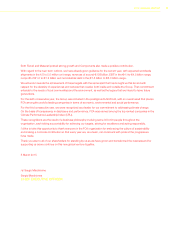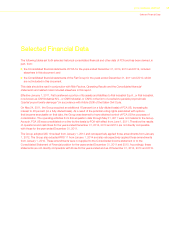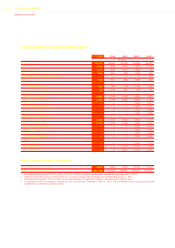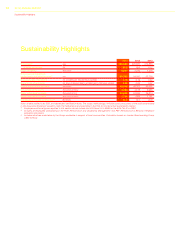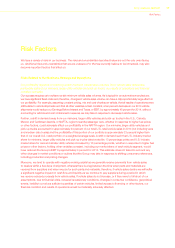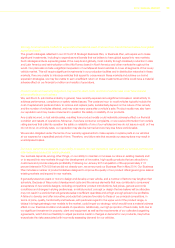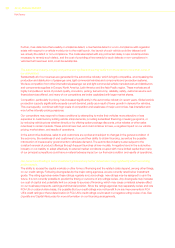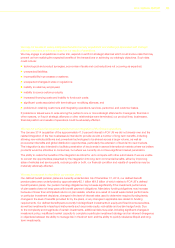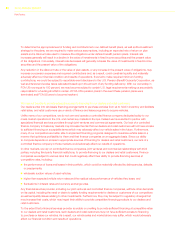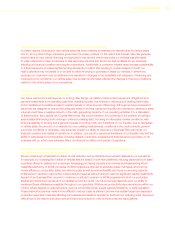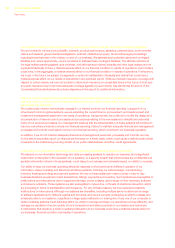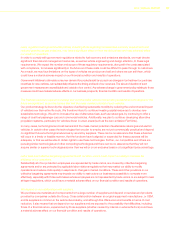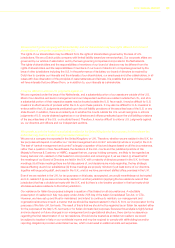Chrysler 2014 Annual Report Download - page 21
Download and view the complete annual report
Please find page 21 of the 2014 Chrysler annual report below. You can navigate through the pages in the report by either clicking on the pages listed below, or by using the keyword search tool below to find specific information within the annual report.
2014 | ANNUAL REPORT 19
We may be unsuccessful in efforts to expand the international reach of some of our brands that we believe have global
appeal and reach.
The growth strategies reflected in our 2014-2018 Strategic Business Plan, or Business Plan, will require us to make
significant investments, including to expand several brands that we believe to have global appeal into new markets.
Such strategies include expanding sales of the Jeep brand globally, most notably through localized production in Asia
and Latin America and reintroduction of the Alfa Romeo brand in North America and other markets throughout the
world. Our plans also include a significant expansion of our Maserati brand vehicles to cover all segments of the luxury
vehicle market. This will require significant investments in our production facilities and in distribution networks in these
markets. If we are unable to introduce vehicles that appeal to consumers in these markets and achieve our brand
expansion strategies, we may be unable to earn a sufficient return on these investments and this could have a material
adverse effect on our financial condition and results of operations.
Product recalls and warranty obligations may result in direct costs, and loss of vehicle sales could have material
adverse effects on our business.
We, and the U.S. automotive industry in general, have recently experienced a significant increase in recall activity to
address performance, compliance or safety-related issues. The costs we incur to recall vehicles typically include the
cost of replacement parts and labor to remove and replace parts, substantially depend on the nature of the remedy
and the number of vehicles affected, and may arise many years after a vehicle’s sale. Product recalls may also harm
our reputation and may cause consumers to question the safety or reliability of our products.
Any costs incurred, or lost vehicle sales, resulting from product recalls could materially adversely affect our financial
condition and results of operations. Moreover, if we face consumer complaints, or we receive information from vehicle
rating services that calls into question the safety or reliability of one of our vehicles and we do not issue a recall, or if we
do not do so on a timely basis, our reputation may also be harmed and we may lose future vehicle sales.
We are also obligated under the terms of our warranty agreements to make repairs or replace parts in our vehicles
at our expense for a specified period of time. Therefore, any failure rate that exceeds our assumptions may result in
unanticipated losses.
Our future performance depends on our ability to expand into new markets as well as enrich our product portfolio and
offer innovative products in existing markets.
Our success depends, among other things, on our ability to maintain or increase our share in existing markets and/
or to expand into new markets through the development of innovative, high-quality products that are attractive to
customers and provide adequate profitability. Following our January 2014 acquisition of the approximately 41.5
percent interest in FCA US that we did not already own, we announced our Business Plan in May 2014. Our Business
Plan includes a number of product initiatives designed to improve the quality of our product offerings and grow sales in
existing markets and expand in new markets.
It generally takes two years or more to design and develop a new vehicle, and a number of factors may lengthen that
schedule. Because of this product development cycle and the various elements that may contribute to consumers’
acceptance of new vehicle designs, including competitors’ product introductions, fuel prices, general economic
conditions and changes in styling preferences, an initial product concept or design that we believe will be attractive
may not result in a vehicle that will generate sales in sufficient quantities and at high enough prices to be profitable.
A failure to develop and offer innovative products that compare favorably to those of our principal competitors, in
terms of price, quality, functionality and features, with particular regard to the upper-end of the product range, or
delays in bringing strategic new models to the market, could impair our strategy, which would have a material adverse
effect on our financial condition and results of operations. Additionally, our high proportion of fixed costs, both due to
our significant investment in property, plant and equipment as well as the requirements of our collective bargaining
agreements, which limit our flexibility to adjust personnel costs to changes in demand for our products, may further
exacerbate the risks associated with incorrectly assessing demand for our vehicles.


